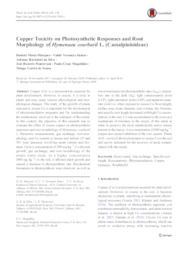Copper toxicity on photosynthetic responses and root morphology of Hymenaea courbaril L. (Caesalpinioideae).
Copper toxicity on photosynthetic responses and root morphology of Hymenaea courbaril L. (Caesalpinioideae).
Autoria: MARQUES, D. M.; VERONEZE JÚNIOR, V.; SILVA, A. B. da; MANTOVANI, J. R.; MAGALHAES, P. C.; SOUZA, T. C. de
Resumo: Copper (Cu) is a micronutrient essential for plant development. However, in excess, it is toxic to plants and may cause various physiological and morphological changes. The study of the growth of plants exposed to excess Cu is important for the development of phytoremediation programs and for understanding the mechanisms involved in the tolerance of this metal. In this context, the objective of this research was to evaluate the effect of excess copper on photosynthetic responses and root morphology ofHymenaeacourbaril L. Biometric measurements, gas exchange, root morphology, and Cu content in tissues and indices (TI and TF) were assessed, involving metal content and biomass.Uptoaconcentrationof200mgkg−1,Cufavored growth, gas exchange, and root morphology of the plants under study. At a higher concentration (800 mg kg−1) in the soil, it affected plant growth and caused a decrease in photosynthetic rate. Biochemical limitations in photosynthesis were observed, as well as lower maximum net photosynthetic rate (Amax), respiration rate in the dark (Rd), light compensation point (LCP), light saturation point (LSP), and apparent quantum yield (α), when exposed toexcess Cu. Root length, surface area, mean diameter, root volume, dry biomass, andspecificrootlengthdecreasedwithhighCuconcentrationsinthe soil.Cuwasaccumulatedintheroots asa mechanism of tolerance to the excess of this metal in order to preserve the most metabolically active tissues presentintheleaves.Ataconcentrationof800mgkg−1, copper also caused inhibition of the root system. Plants ofH.courbarilshowedtolerancetoexcessCuinthesoil and can be indicated for the recovery of areas contaminated with this metal.
Ano de publicação: 2018
Tipo de publicação: Artigo de periódico
Unidade: Embrapa Milho e Sorgo
Palavras-chave: Cobre, Metal Pesado, Phytoremediation, Raiz, Toxicidade, Troca de gás
Observações
1 - Por padrão são exibidas publicações dos últimos 20 anos. Para encontrar publicações mais antigas, configure o filtro ano de publicação, colocando o ano a partir do qual você deseja encontrar publicações. O filtro está na coluna da esquerda na busca acima.
2 - Para ler algumas publicações da Embrapa (apenas as que estão em formato ePub), é necessário ter, no celular ou computador, um desses softwares gratuitos. Sistemas Android: Google Play Livros; IOS: iBooks; Windows e Linux: software Calibre.
Acesse outras publicações
Acesse a Base de Dados da Pesquisa Agropecuária (BDPA) para consultar o acervo completo das bibliotecas da Embrapa.

